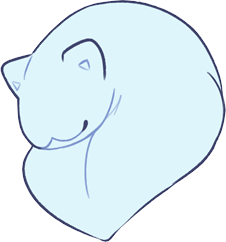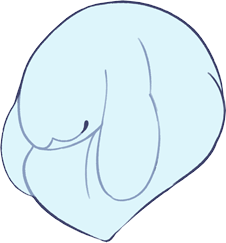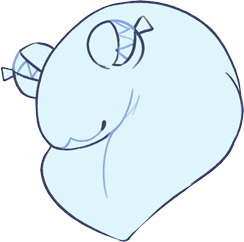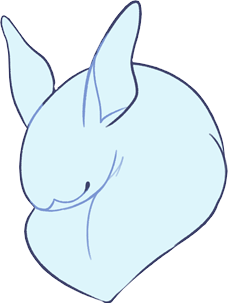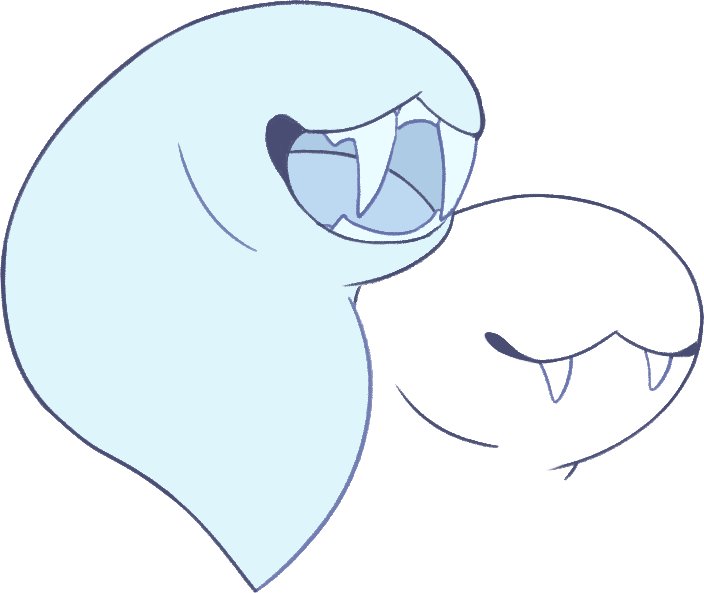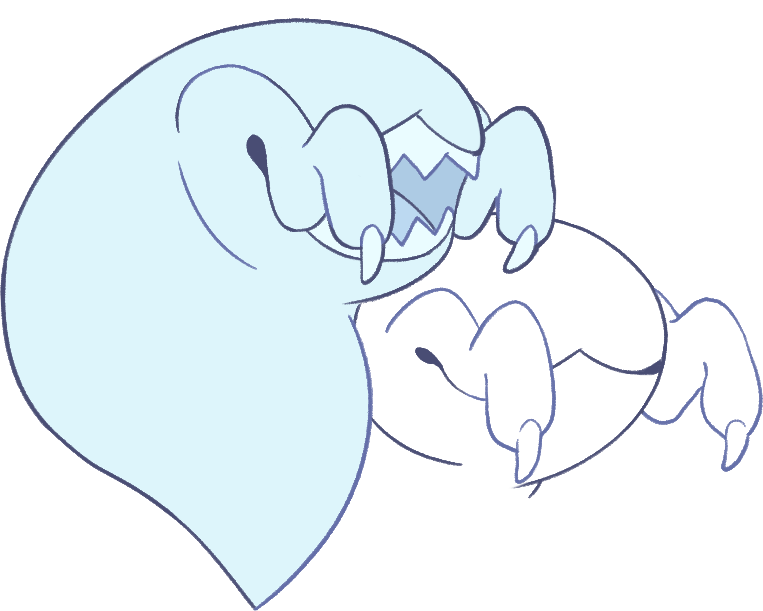Traits
Star tip ears (Normal)
Ears that end in short stylized points.
Most commonly seen in a similar shape to bun ears, they can actually vary from just showing the pointed tips on the head, to hanging down at any length. These ears cannot be moved by the leech.
Note: The tips must remain short. Longer moveable points should instead be classed as the Myth trait, hand ears!
Triangle ears (Normal)
Soft and pointed ears.
Argued to be a variant of cub ears, it’s most often bred on pet class leeches and mimics other animals. The little shaped cavity in each ear attunes the leech more to vibrations of sound, giving the illusion that these ears can hear.
Bun ears (Normal)
Round, long feelers that hang down a leech's face.
They occur most commonly in pets and wild class. Occasionally these ears develop with a slight amount of fat or cartilage, allowing them to stand on end, but the leech cannot otherwise move them.
They have less sensory input than most feelers and ears, and as a result a leech can sometimes be seen chewing on them as some sort of comfort or stress relief.
Axolotl ears (Normal)
A combined triple set of feelers, each with a sensitive fan of skin.
These ears are incredible at picking up sound and vibrations in water, but they are just as incredibly fragile. Thankfully, they can be regrown within two weeks if damaged.
Note: There can be more or less than three, but a single pair of the feelers would be classed as the Myth trait moth ears.
Zipper ears (Normal)
Cartilage in a jagged-tooth shape, set into a hollow set of ears that can open to reveal another set of ears underneath.
A companion trait to the tailmouth hoodie. The zipper ears can be any shape, but are generally rounder and smaller than the inside ear set.
Note: The zipper must go the length of the leech's ears from the tip, and cannot cut across them horizontally.
False wing ears (Normal)
Wide, thin feelers with notches.
They may look stylized and featherlike, but they are made of skin, and built to imitate birds while the leech hides in wait.
Dobby ears (Normal)
Thin-skinned ears that fold in at the base around an ear canal.
Notably, the only ear type that functions properly as ears. They pick up sound, therefore leeches that have this trait rely on hearing more than they do on sound vibration.
Popular on pets for their aesthetic and for allowing the leech to actually hear verbal commands.
Brush ears (Normal)
Extremely delicate wide ears that drape down a leech's face.
A companion trait to brush tail, these ears are so thin-skinned that they tear easily, giving them a ragged appearance.
Squint eyes (Normal)
Narrow slit-looking eyes, usually without a pronounced pupil.
A close variant of shut eyes, but for whatever reason the leech cannot keep them closed all the way. These leeches still tend to have poor eyesight, but the trait is popular on pets to give the appearance of smiling very hard.
Bead eyes (Normal)
A type of eye that is characteristically small, round and pupil-less.
Bead-eyed leeches are generally masters of hiding their eyes in plain sight, as they are often small and easily mistaken for natural markings or gemstones. These eyes are still soft and will upset the leech if poked, so care must be taken to notice where they are on the leech when petting!
Mammalian eyes (Normal)
Middle-sized expressive eyes, often used as a catch-all term for eyes that are not any of the other types.
Mammalian eyes can be any shape and color, and may or may not have pupils, but always feature points at either end similarly to our own. The strength of the eyesight varies from leech to leech and is also tied to its placement on the body.
See-all eyes (Normal)
An unusual eye type that is solid like a marble and often feature exquisite designs and patterns on their surface.
Their notable feature is the ability to appear elsewhere on the body, as long as an eye socket is present. In this sense, each socket counts as an eye regardless of actual eyes present, and more than five is considered a myth trait.
The leech carefully guards these travelling eyes as losing one out of the body is exceptionally painful, and immediately results in blindness of that eye. Once a See-all eye stops functioning, the leech will abandon it without exception; this is usually the reason for a leech having fewer eyes than number of sockets.
In collectors' circles, removed see-all eyes are incredibly valuable, resulting in high rates of poaching for these beautiful items - especially since it is randomly-occurring and cannot be bred.
Note: See-all eyes cannot be held in the mouth or by the tongue; this is considered retired. Any leech with this presentation cannot maintain it through a redesign.
Outward vampire teeth (Normal)
A genetic defect where the vampiric points of the leech's upper and lower teeth have become bigger and wider than normal, angling out more than the standard variety.
These leeches usually exhibit an underbite, where the bottom two points will stick uncomfortably out of the mouth similarly to bulldogs. While outward vampire leeches live otherwise healthy and happy lives, many regard this particular variant as a sign of poor breeding.
Squid Teeth (Normal)
The teeth in this leech's mouth have developed into a single point on the upper and lower jaw, resembling the beak of a squid.
These leeches will always have an overbite, and the top tooth is visible when the mouth is closed. Squid-toothed leeches are experts at piercing holes in things, whether it be hard shells, seafood, containers, or plastic recycling bins. The 'beak' is very dexterous!
Clinger Teeth (Normal)
Mimicking the functionality and form of the creatures that leeches are named after, the clinger variation features one tooth in the shape of a solid, serrated ring.
It is controlled by muscles in the leech's head that let it sit further back in the throat and move forward into position when the leech opens its mouth. These muscles are very powerful and bring the teeth forward with a lot of force in order to pierce the flesh of its victims with certainty - clinger leeches do not let go of their prey until they have siphoned every last drop of blood from it.
Rather than hard enamel or similar plating, these teeth are composed of strong cartilage, giving them the flexibility to contract.
Saber Teeth (Normal)
A unique variation that builds off the vampire teeth crescents, but adds two additional teeth plates to the upper jaw. These teeth extend into notably long fangs, with the much-smaller crescent bridging between them.
These leeches always have an overbite, allowing the saber 'fangs' to peek out when the mouth is closed. While these fangs can be any length, leeches with longer saber teeth often have trouble opening and closing their mouths comfortably.
Saw Teeth (Normal)
A mutation where points have grown across the whole tooth rather than just at the ends, creating the appearance of a mouth full of teeth.
Like vampire teeth, the leech will have an over- or underbite, if the teeth notches are not built in a way to slot together evenly.
Saw-toothed leeches are very effective at stripping meat from bones and will happily tear through the carcass of their prey. It is considered undesired trait in most pets and mounts, especially if the individual displays nipping tendencies - careless saw teeth can easily remove a finger or take a bite out of a limb.
Note: the inverse points do not reach the gumline; it is still a single solid plate, like a cookie cutter shark.
+Blush jaw (Normal)
A lesser jaw trait where a pocket develops at the corner of the leech's mouth in the same fashion as a container mutation might, giving the leech the appearance of having cute cheeks.
These differ from markings in that the cheek is functional and can be used by the leech to display blood, fluid, or small trinkets that it feels have value. Incredibly docile leeches may even allow their owners to customize the cheek pockets with their own things, making this trait a popular pick for the decora and ita scenes.
Note: It may be accompanied by any type of teeth.
+Spider jaw (Normal)
A popular feature on insectoid leeches, the spider jaw features an advanced claw-tipped feeler that has developed muscles and can be moved about or used to help the leech feed.
The feelers can originate outside or inside the mouth.
These feelers are generally very receptive to touch, and often feature a claw or pointed end as their main use is for grabbing and directing things into the leech's mouth. Claws can be filed down for safety, but the leech must first be trained to be comfortable with this procedure - since the claws are in such close proximity to the mouth it can be easy to receive a bite from a fussy or upset leech.
Note: It may be accompanied by any type of teeth.

